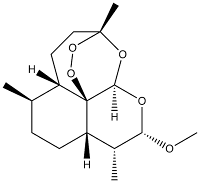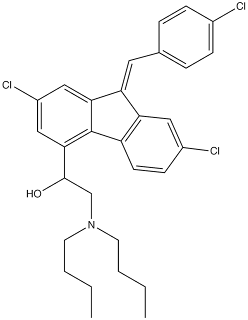New Drug Approvals - Pt. VI - Artemether/Lumefantrine (Coartem)

Next in our series of posts on 2009 new drug approvals is a mixture of Artemether (USAN) - a methyl ether derivative of artemisinin, and Lumefantrine (USAN) - a racemic mixture of a synthetic racemic fluorene derivative formerly known as benflumetol. The combination of these two drugs in one product was approved on April 7th. The mixture is marketed under the trade name Coartem, for the treatment of acute, uncomplicated malaria infections due to Plasmodium falciparum, the causative parasite of the most aggressive form of the disease. Artemether and Lumefantrine are both small molecule drugs (molecular weights of 298.4 g.mol-1 and 528.9 g.mol-1, respectively), lipophilic, and are both essentially insoluble in water. Artemether is fully Rule-of-Five compliant, whereas Lumefantrine is not.
Artemether and Lumefantrine have increased oral absorption when administrated with food and display high plasma protein binding of 95.4% and 99.7%, respectively. Artemether and Lumefantrine are both metabolized mainly by CYP3A4 are therefore have many drug-drug interactions with substrates, inhibitors and inducers of CYP3A4. Artemether is extensively metabolized to Dihydroartemisin (DHA), which then undergoes rapid clearance. Therefore, Artemether, which has an elimination half-life of 2 hours, is administrated with Lumefantrine, which has a much longer and pharmacologically complementary terminal half-life of 3-6 days and therefore the two drugs act synergistically against Plasmodium.
Recommended dosage and full prescribing information can be found here.
The Artemether structure is (3R,5aS,6R,8aS,9R,10S,12R,12aR)-decahydro-10-methoxy-3,6,9-trimethyl-3,12-epoxy-12H-pyrano[4,3-j]-1,2-benzodioxepine. The molecule is extremely rigid, with very few rotational bonds. An important chemical feature and unique in drugs is the presence of a peroxide bond (the O-O single bond), which is essential for the antimalarial activity.
Artemether canonical SMILES: C[C@@H]1CC[C@@H]3C42OO[C@](C)(CC[C@@H]12)O[C@H]4O[C@H](OC)[C@@H]3C Artemether InChI: InChI=1/C16H26O5/c1-9-5-6-12-10(2)13(17-4)18-14-16(12)11(9)7-8-15 (3,19-14)20-21-16/h9-14H,5-8H2,1-4H3/t9-,10-,11+,12+,13+,14-,15-, 16?/m1/s1 Artemether InChIKey: SXYIRMFQILZOAM-LJXHFVHTBB Artemether CAS registry: 71963-77-4 Artemether ChemDraw: Artemether.cdx
The Lumefantrine structure is (±)-2-dibutylamino-1-[2,7-dichloro-9-(4-chlorobenzylidene)-9H-fluorene-4-yl]ethanol. The molecule is an amino-alcohol, with a tertiary amine (which can be protonated and therefore Lumefantrine is normally positively charged). It also contains a racemic stereocenter at the carbon to which the hydroxyl group is attached. Since the drug is racemic, the stereoisomers have different pharmacological activity, and differing metabolic properties. The remainder of the molecule is quite rigid, with two chlorophenyls fused together by a five-membered ring with a substituted benzylidene group.
Lumefantrine canonical SMILES: Clc1ccc(cc1)\C=C3/c4c(c2c(cc(Cl)cc23)C(O)CN(CCCC)CCCC)ccc(Cl)c4 Lumefantrine InChI: InChI=1/C30H32Cl3NO/c1-3-5-13-34(14-6-4-2)19-29(35)28-18-23(33)17 -27-25(15-20-7-9-21(31)10-8-20)26-16-22(32)11-12-24(26)30(27)28/h 7-12,15-18,29,35H,3-6,13-14,19H2,1-2H3/b25-15+ Lumefantrine InChIKey: DYLGFOYVTXJFJP-MFKUBSTIBV Lumefantrine CAS registry: 82186-77-4 Lumefantrine ChemDraw: Lumefantrine.cdx
The manufacturer of Artemether/Lumefantrine combination is Novartis and the product website is www.coartem.com


